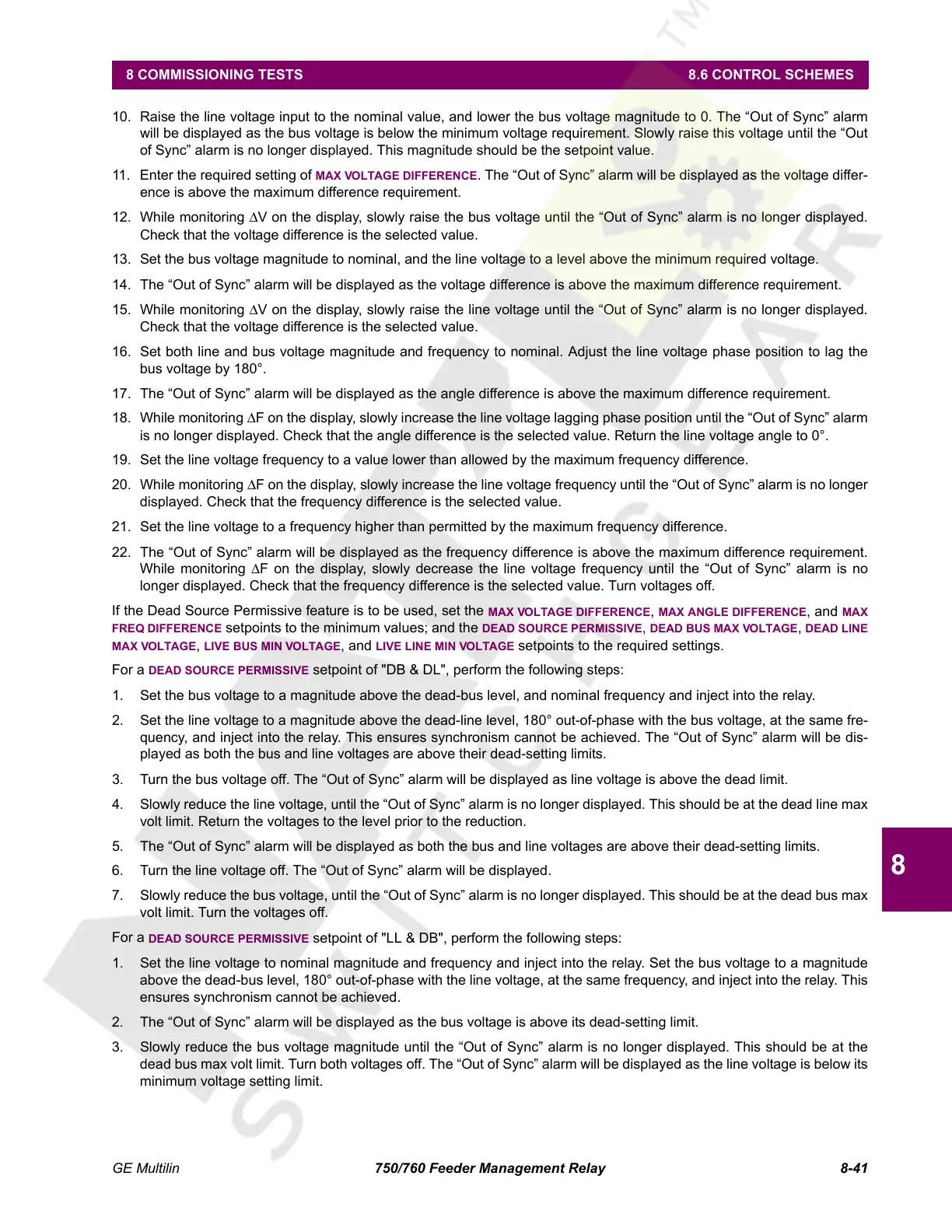GE Multilin 750/760 Feeder Management Relay 8-41
8 COMMISSIONING TESTS 8.6 CONTROL SCHEMES
8
10. Raise the line voltage input to the nominal value, and lower the bus voltage magnitude to 0. The “Out of Sync” alarm
will be displayed as the bus voltage is below the minimum voltage requirement. Slowly raise this voltage until the “Out
of Sync” alarm is no longer displayed. This magnitude should be the setpoint value.
11. Enter the required setting of MAX VOLTAGE DIFFERENCE. The “Out of Sync” alarm will be displayed as the voltage differ-
ence is above the maximum difference requirement.
12. While monitoring ΔV on the display, slowly raise the bus voltage until the “Out of Sync” alarm is no longer displayed.
Check that the voltage difference is the selected value.
13. Set the bus voltage magnitude to nominal, and the line voltage to a level above the minimum required voltage.
14. The “Out of Sync” alarm will be displayed as the voltage difference is above the maximum difference requirement.
15. While monitoring ΔV on the display, slowly raise the line voltage until the “Out of Sync” alarm is no longer displayed.
Check that the voltage difference is the selected value.
16. Set both line and bus voltage magnitude and frequency to nominal. Adjust the line voltage phase position to lag the
bus voltage by 180°.
17. The “Out of Sync” alarm will be displayed as the angle difference is above the maximum difference requirement.
18. While monitoring ΔF on the display, slowly increase the line voltage lagging phase position until the “Out of Sync” alarm
is no longer displayed. Check that the angle difference is the selected value. Return the line voltage angle to 0°.
19. Set the line voltage frequency to a value lower than allowed by the maximum frequency difference.
20. While monitoring ΔF on the display, slowly increase the line voltage frequency until the “Out of Sync” alarm is no longer
displayed. Check that the frequency difference is the selected value.
21. Set the line voltage to a frequency higher than permitted by the maximum frequency difference.
22. The “Out of Sync” alarm will be displayed as the frequency difference is above the maximum difference requirement.
While monitoring ΔF on the display, slowly decrease the line voltage frequency until the “Out of Sync” alarm is no
longer displayed. Check that the frequency difference is the selected value. Turn voltages off.
If the Dead Source Permissive feature is to be used, set the
MAX VOLTAGE DIFFERENCE, MAX ANGLE DIFFERENCE, and MAX
FREQ DIFFERENCE setpoints to the minimum values; and the DEAD SOURCE PERMISSIVE, DEAD BUS MAX VOLTAGE, DEAD LINE
MAX VOLTAGE, LIVE BUS MIN VOLTAGE, and LIVE LINE MIN VOLTAGE setpoints to the required settings.
For a
DEAD SOURCE PERMISSIVE setpoint of "DB & DL", perform the following steps:
1. Set the bus voltage to a magnitude above the dead-bus level, and nominal frequency and inject into the relay.
2. Set the line voltage to a magnitude above the dead-line level, 180° out-of-phase with the bus voltage, at the same fre-
quency, and inject into the relay. This ensures synchronism cannot be achieved. The “Out of Sync” alarm will be dis-
played as both the bus and line voltages are above their dead-setting limits.
3. Turn the bus voltage off. The “Out of Sync” alarm will be displayed as line voltage is above the dead limit.
4. Slowly reduce the line voltage, until the “Out of Sync” alarm is no longer displayed. This should be at the dead line max
volt limit. Return the voltages to the level prior to the reduction.
5. The “Out of Sync” alarm will be displayed as both the bus and line voltages are above their dead-setting limits.
6. Turn the line voltage off. The “Out of Sync” alarm will be displayed.
7. Slowly reduce the bus voltage, until the “Out of Sync” alarm is no longer displayed. This should be at the dead bus max
volt limit. Turn the voltages off.
For a
DEAD SOURCE PERMISSIVE setpoint of "LL & DB", perform the following steps:
1. Set the line voltage to nominal magnitude and frequency and inject into the relay. Set the bus voltage to a magnitude
above the dead-bus level, 180° out-of-phase with the line voltage, at the same frequency, and inject into the relay. This
ensures synchronism cannot be achieved.
2. The “Out of Sync” alarm will be displayed as the bus voltage is above its dead-setting limit.
3. Slowly reduce the bus voltage magnitude until the “Out of Sync” alarm is no longer displayed. This should be at the
dead bus max volt limit. Turn both voltages off. The “Out of Sync” alarm will be displayed as the line voltage is below its
minimum voltage setting limit.
Courtesy of NationalSwitchgear.com

